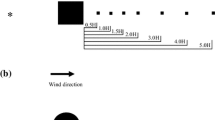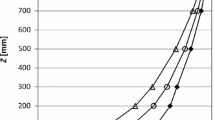Abstract
The dispersion of tracers within a large array of obstacles is investigated in a boundary-layer wind-tunnel simulation. The experiment models at 1:50 scale a large outdoor field study that simulated an urban boundary layer with an array of shipping containers, known as MUST (Mock Urban Setting Test – Yee and Biltoft, 2004, Boundary-Layer Meteorology 111, 363–415). The wind-tunnel results are reported and discussed in detail, and some comparisons are drawn to the outdoor field trial and previous studies of plume dispersion within obstacle arrays, as well as open terrain. The analysis covers a wide range of concentration statistics and other quantitative descriptors of plume behaviour, giving a comprehensive treatment of the physical mechanisms involved in the development of a dispersing plume within an ‘urban-like’ environment. Emphasis is placed on the description and mathematical modelling of concentration fluctuations within the plume, as well as the usual mean concentration results. Some discussion is also centred on the physical similarities and differences between scaled model simulations and full-scale dispersion experiments, and some possibly surprising influences of upwind flow conditioning on obstacle array dispersion that require more careful attention
Similar content being viewed by others
Abbreviations
- MUST:
-
Mock Urban Setting Test
- AS1170.2-1989:
-
Australian Standard 1170.2 (1989) (Australian Wind Loading Code)
References
Baechlin W., Theurer W., Plate E.J. (1991). ‘Wind Field Dispersion in a Built-Up Area – A Comparison Between Field Experiments and Wind Tunnel Data’. Atmos. Environ. 25A:1135–1142
Baechlin W., Theurer W., Plate E.J. (1992). ‘Dispersion of Gases Released Near the Ground in Built-Up Areas: Experimental Results Compared to Simple Numerical Modeling’. J. Wind Eng. Ind. Aero. 41–44:2721–2732
Barry P.J. (1977). Sulphur and its Inorganic Derivatives in the Canadian Environment:Chapt. Stochastic Properties of Atmospheric Diffusivity, National Research Council of Canada, pp. 313–358.
Biltoft C.A. (2001). ‘Customer Report for Mock Urban Setting Test’, Technical Report WDTC-FR-01-121. U.S. Army Dugway Proving Ground, Dugway, Utah
Biltoft C.A., Yee E., Jones C.D. (2002). ‘Overview of the Mock Urban Setting Test’. In Fourth Symposium on the Urban Environment. Norfolk, Virginia, USA
Davidson M.J., Mylne K.R., Jones C.D., Phillips J.C., Perkins R.P., Fung J.C.H., Hunt J.C.R. (1995). ‘Plume Dispersion Through Large Groups of Obstacles – A Field Investigation’. Atmos. Environ. 29:3245–3256
Davidson M.J., Snyder W.H., Lawson R.E Jr., Hunt J.C. R. (1996). ‘Wind Tunnel Simulations of Plume Dispersion through Groups of Obstacles’. Atmos. Environ. 30:3715–3731
Deaves D.M., Harris R.I. (1978). ‘A Mathematical Model of the Structure of Strong Winds’, Technical Report76. Construction Industry Research and Information Association, U.K
Gailis R.M. (2004). ‘Wind Tunnel Simulations of the Mock Urban Setting Test – Experimental Procedures and Data Analysis’, Technical Report DSTO-TR-1532. Defence Science and Technology Organisation, Australia
Gailis R.M., Yee E. (2002). ‘Wind Tunnel Simulations of the Mock Urban Setting Test at Dugway’. In: Hanna S (eds). Sixth Annual George Mason University Transport and Dispersion Modeling Workshop:Fairfax, Virginia.
Hall D.J., Macdonald R., Walker S., Spanton A.M. (1996). ‘Measurements of Dispersion Within Simulated Urban Arrays – A Small Scale Wind Tunnel Study’. Client Report CR 178/96, Building Research Establishment Ltd., Garston, Watford, UK
Hall D.J., Spanton A.M., Macdonald R., Walker S. (1997). ‘A Simple Model for Estimating Dispersion in Urban Areas’. Client Report CR 169/97, Building Research Establishment Ltd., Garston, Watford, U.K
Hanna S.R. (1984). ‘The Exponential Probability Density Function and Concentration Fluctuations in Smoke Plumes’. Boundary-Layer Meteorol. 29:361–375
Harris R.I. (1990). ‘Some Further Thoughts on the Spectrum of Gustiness in Strong Winds’. J. Wind Eng. Ind. Aero. 33:461–477
Hosker R.P. (1984). ‘Flow and Diffusion Near Obstacles’. In: Randerson D (eds). Atmospheric Science and Power Production:No3. Technical Information Center, U.S. Department of Energy, Washington, DC, Chapt 7, pp. 241–326
Hosker R.P. (1985). ‘Flow Around Isolated Structures and Building Clusters: A Review’. ASHRAE Trans. 21(2B):1671–1692
International Organisationfor Standardisation (ISO). (1995). ‘Guide to the Expression of Uncertainty in Measurement’. Geneva Switzerland
Kaimal J., Finnigan J. (1994). Atmospheric Boundary Layer Flows – Their Structure and Measurement. Oxford University Press, Oxford, U.K, pp.
Lewellen W.S., Sykes R.I. (1986). ‘Analysis of Concentration Fluctuations from Lidar Observations of Atmospheric Plumes’. J. Climate Appl. Meteorol. 25:1145–1154
Macdonald R.W., Griffiths R.F., Cheah S.C. (1997). ‘Field Experiments of Dispersion Through Regular Arrays of Cubic Structures’. Atmos. Environ. 31:783–795
Macdonald R.W., Griffiths R.F., Hall D.J. (1998). ‘A Comparison of Results from Scaled Field and Wind Tunnel Modeling of Dispersion in Arrays of Obstacles’. Atmos. Environ.32:3845–3862
Melbourne W.H. (1977). ‘Development of Natural Wind Models at Monash University’, in Proceedings of the 6th Australian Hydraulics and Fluid Mechanics Conference :Adelaide, pp. 190–194.
Meroney R.N. (1982). ‘Turbulent Diffusion Near Buildings’. In: Plate E.J (eds). Engineering Meteorology. Elsevier, Amsterdam, Chapt.8, pp. 481–525
Mylne K.R., Mason P.J. (1991). ‘Concentration Measurements in a Dispersing Plume at a Range of up to 1000 m’. Quart. J. Roy. Meteorol. Soc. 117:177–206
Panofsky H.A., Dutton J.A. (1984). Atmospheric Turbulence, Models and Methods for Engineering Applications. John Wiley & Sons, New York U.S.A., pp.
Pasquill F. (1983). Atmospheric Diffusion. John Wiley & Sons, New York, U.S.A
Press W.H., Teukolsky S.A., Vetterling W.T., Flannery B.P. (1996). Numerical Recipes in C: The Art of Scientific Computing, 2nd edn. Cambridge University Press, Cambridge, UK
Rosenblatt M. (1956). ‘Remarks on Some Non-parametric Estimates of a Density Function’. Ann. Math. Stat. 42:1815–1842
Standards Association ofAustralia: 1989, ‘Australian Wind Loading Code (AS1170.2-1989)’, 5th edn., North Sydney.
Stern A.C., Boubel R.W., Turner D.B., Fox D.L. (1984). Fundamentals of Air Pollution, 2nd edn. Academic Press, New York
Stull R.B. (1988). An Introduction to Boundary Layer Meteorology. Kluwer, Dordrecht The Netherlands, 666 pp
Terrell G.R. (1990). ‘The Maximal Smoothing Principle in Density Estimation’. J. Am. Stat. Assoc. 85(410): 470–477
Theurer W., Plate E.J., Hoeschele K. (1996). ‘Semi-Empirical Models as a Combination of Wind Tunnel and Numerical Dispersion Modeling’. Atmos. Environ. 30:3583–3597
VonKarman T. (1948). ‘Progress in Statistical Theory of Turbulence’. Proc. Natl. Acad. Sci. (USA) 34:530–539
Yee E., Biltoft C.A. (2002a). ‘On the Structure of Plumes Dispersing Through a Large Array of Obstacles’. In Hanna S (eds). Sixth Annual George Mason University Transport and Dispersion Modeling Workshop, Fairfax, Virginia.
Yee E., Biltoft C.A. (2002b), ‘Preliminary Results of the MUST Diffusion Experiment’, in Fourth Symposium on the Urban Environment, Norfolk, Virginia, U.S.A.
Yee E., Biltoft C.A. (2004). ‘Concentration Fluctuation Measurements in a Plume Dispersing through a Regular Array of Obstacles’. Boundary-Layer Meteorol. 111:363–415
Yee E., Chan R. (1997). ‘A Simple Model for the Probability Density Function of Concentration Fluctuations in Atmospheric Plumes’. Atmos. Environ. 31:991–1002
Yee E., Chan R., Kosteniuk P.R., Chandler G.M., Biltoft C.A., Bowers J.F. (1994). ‘Experimental Measurements of Concentration Fluctuations and Scales in a Dispersing Plume in the Atmospheric Surface Layer Obtained Using a Very Fast Response Concentration Detector’. J. Appl. Meteorol. 33:996–1016
Yee E., Chan R., Kosteniuk P.R., Chandler G.M., Biltoft C.A., Bowers J.F. (1995). ‘The Vertical Structure of Concentration Fluctuation Statistics in Plumes Dispersing in the Atmospheric Surface Layer’. Boundary-Layer Meteorol. 76:41–67
Yee E., Kosteniuk P.R., Chandler G.M., Biltoft C.A., Bowers J.F. (1993). ‘Statistical Characteristics of Concentration Fluctuations in Dispersing Plumes in the Atmospheric Surface Layer’. Boundary-Layer Meteorol. 65:69–109
Author information
Authors and Affiliations
Corresponding author
Rights and permissions
About this article
Cite this article
Gailis, R.M., Hill, A. A Wind-Tunnel Simulation of Plume Dispersion Within a Large Array of Obstacles. Boundary-Layer Meteorol 119, 289–338 (2006). https://doi.org/10.1007/s10546-005-9029-1
Received:
Accepted:
Published:
Issue Date:
DOI: https://doi.org/10.1007/s10546-005-9029-1




